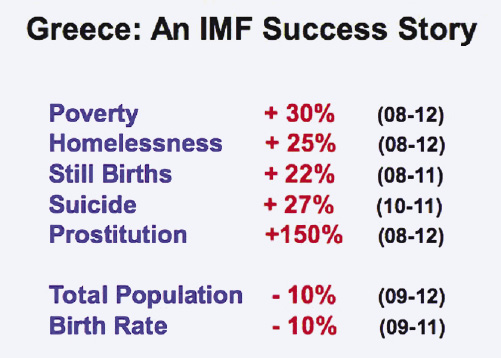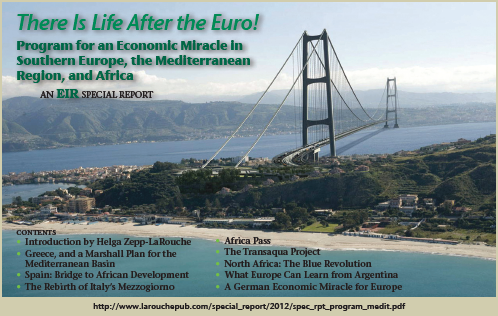A GREEK PROPOSAL
Convene a European Debt Conference for 2015
by Dean Andromidas and Paul Gallagher

Creative Commons
Syriza leader Alexis Tsipris told the BBC: “What we are asking for is a European conference. . . . There is no other solution to the problem but to delete a big part of the debt. . . .” |
This article appears in the January 23, 2015 issue of Executive Intelligence Review and is reprinted with permission.
A European-wide debt conference similar to the conference that led to the London Debt Agreement of 1953 that settled the foreign debts of Germany has been proposed by both the Greek Syriza Party and the Independent Greeks, and has been making headlines in the European media.
In an interview with Great Britain’s BBC4, the leader of Syriza, Alexis Tsipras, said, “What we are asking for is a European conference in order for all of us united to address this European problem. There is no other solution to the problem but to delete a big part of the debt, a new Memorandum on the repayment and a new development clause.” He added, “In reality we are not asking any more money or loans in order to repay the old debts. Obviously, we will negotiate with our partners in order for all of us united to address the Greek debt issue.”
Syriza proposes that such a conference would not only deal with the Greek debt but that of other countries that negotiated harsh austerity conditionalities with the “Troika” in order to bail out their bankrupt banks, including Ireland, Portugal, Cyprus, and Europe as a whole.
The convening of such a conference is an excellent opportunity not only to settle the Greek debt crisis but to reorganize and reform the entire European financial system. The real issue is not the Greek debt, but bankruptcy reorganization of the entire Eurozone, and more broadly, the trans-Atlantic financial system. The crucial task is to restore national sovereignty to the nation-states of the Eurozone so as to re-establish a regime of national credit systems on Hamiltonian principles that would enable the European and North American nations to participate in the emerging world system of development being carried out by the BRICS and allied nations.
The London Debt Agreement of 1953
The German debt conference refers to the 1952 conference held in London, which led to the “Agreement on German External Debts” of 1953. The Conference settled the German inter-war public and private foreign debt, as well as the postwar Marshall Plan concessionary loans debt. On much of this debt, there had been no payments at all since 1934, when the Nazi government suspended payments. The total of $38.8 billion in Germany’s debts was reduced by the conference to $14.5 billion.

Creative Commons/Stockholm Transport Museum
Hamburg, Germany still looked like this in 1950, five years after the end of the war, and before the London Debt Agreement of 1953 kicked in. |
Under prodding by the United States in the context of the Bretton Woods System, the London Debt Conference of 1952-53—which produced an economic success, in the rapid recovery and growth of the German economy, known as the “German economic miracle”—was conducted on principles quite opposed to those demanded of indebted countries by the current “Troika” of the IMF, the European Central Bank (ECB), and the European Commission in Brussels. Those principles were:
• that Germany had to be able to pay back debt while maintaining a high level of growth and improving the living standards of its population;
• that Germany be able to repay its debts in its own currency, rather than in dollars or other stronger currencies; and this, while the D-mark would remain relatively undervalued;
• that Germany’s debt payments would never exceed 5% of its export revenues in any year, and that the country be encouraged to develop its production, as a substitute for imports, in order to have a positive trade balance.
The very purpose of the negotiation was to settle the debt question so as to facilitate the most rapid recovery and expansion of the German and European economy as a whole, as was explicitly stated in the preamble of the agreement:
“Desiring to remove obstacles to normal economic relations between the Federal Republic of Germany and other countries and thereby to make a contribution to the development of a prosperous community of nations. . . .”
All the foreign debt, public and private, was to be settled in a comprehensive manner and by treaty, so that it was not subject to foreign court actions such as in the current Argentine case.
There was an average write-down of more than 60% in the principal of the debt, and lowered interest rates on the remainder. Thus the debt was disposed of directly. That is to say, there was no need for any sort of central institution or third party to buy the debt, nor was new debt issued as in the case of the recent bailout of Greek, Irish, Portuguese, and Cypriot debt.
Absolutely no conditionalities were attached. No demands for cuts in the budget and so-called “structural reforms” in order to generate primary surpluses to pay unpayable debt. Hence no austerity measures were demanded.
Under Glass-Steagall Principles
Most important of all, this occurred under a financial system that was on a Glass-Steagall standard of full separation between commercial and investment banking, where the former were forbidden by law to engage in the trading of derivatives and other forms of exotic “financial instruments.” At the same time, powerful credit institutions existed in Germany, most notably the Kreditanstalt für Wiederaufbau (Reconstruction Finance Corporation), which served as Hamiltonian credit institutions to finance industry and infrastructure, leading rapidly to full employment.
There has never been such a debt restructuring since, and none that has been as successful as the one the so-called German economic miracle made so manifest.
Such a restructuring could never be done under the current system, primarily because the debt is part of a system of casino banking, where the so-called sovereign bonds are linked to a labyrinth of derivatives and speculative securities.
Today, the question of resolving the debts and restoring the economies of the Eurozone’s so-called “peripheral” countries, including Greece, is being subjugated to an antagonistic “imperative.” Namely, Wall Street and the City of London demand that the ECB now print trillions of euros to buy up, from the private banks, the sovereign debt of all the European countries.
Why? In order to save scores of large, bankrupt banks which are loaded with trillions in bad debts from real estate, commodity, and other speculations and derivatives—rather than to save the economies of indebted nations. This bailout imperative is being pushed now in near-hysterical tones by banks and their financial “experts” and media whores. It would, if implemented, fix all of Europe in an inescapable zero-growth regime and drastically devalue the euro—which is already, merely on the anticipation of this massive quantitative easing, falling below its original exchange rates with strong currencies.
Therefore, the entire system of European banking and credit has to be reorganized in an orderly manner, as was done under Franklin Roosevelt when the Glass-Steagall Act was passed in 1933, beginning with the separation of banks, and the creation of a national credit institution in the form of the Reconstruction Finance Corporation. This kind of action, with all EU nations at a conference table, makes it possible for Europe to craft a productive solution for the debt crises of Greece, Ireland, Portugal, Cyprus, etc.
A Debt Conference of 2015
FIGURE 1

EIRNS
|
A European debt conference of 2015, while incorporating the principles of the 1953 agreement, would look very different. As everyone should know, the debt crises of Greece, Ireland, Portugal, etc., were the result of the collapse of the private trans-Atlantic financial system. The so-called bailout of these countries was actually a bailout, by Europe’s governments, of the banking system. Greece was denied even a traditional IMF-style bailout, in which a small portion of the debt might be paid off, because the slightest haircut on the debt would have had a disastrous impact on the German, French, British, and other foreign banks that then held the vast majority of Greek debt. The same was the case with Ireland, Portugal, and Cyprus. In Spain, the banks were bailed out directly.
The banks continue to be hopelessly bankrupt, with reports that there is no less than EU2-2.5 trillion of “non-performing” debt sitting in these banks. This is a conservative figure, and does not include the multi-trillions of euros of exposure to derivative bets.
Thus, the first order of business will be to implement a Glass Steagall-style reform, deconstructing the too-big-to-fail system of casino banking with full separation between commercial and investment banking. In separating the banks, the assets will have to be separated as well. Those assets, such as savings deposits, government bonds, and credits linked to the real economy, the loss of which would have a serious detrimental effect on the economy, will be protected and put into the commercial banking system, which would operate under a state-chartered regulatory regime that would forbid these banks from trading on stock markets, etc.
The speculative assets in the investment banks will have to be examined to determine what is viable and what has to be written off. This would naturally lead to a dramatic downsizing of these banks. Many will not survive the reform.
The conference will have to restore sovereign powers to national institutions, as the only recognized authorities with the political and legal mandate to carry out a bankruptcy reorganization of the banking system.
The conference would obviously not entertain any supranational scheme aimed a bailing out the system at the expense of the national governments, and therefore to the detriment of the general welfare.
The conference might offer a forum for resolving conflicts that may arise when deconstructing and separating these huge banks, which have operated across national borders.
By the end of this process, the Glass-Steagall regime, which was the environment within which the 1950s London Debt Conference was conducted, will have been restored.
Creating a European Infrastructure Investment Bank
The second order of business will be to deal with the government debt without the hysteria about contagion and “blowing up the system.” The conference will naturally begin by dealing with the so-called “bailout debt” which fell under the European Stability Mechanism (ESM), which was formed to issue the bailout bonds with a guarantee of the governments of the European Union (EU).
These bonds include the EU246 billion for the Greek bailout; the EU76.8 billion for Portugal; the EU68 billion for Ireland; the EU41 billion for Spain; as well as smaller sums for Cyprus, Hungary, Latvia, and Romania. The total is EU487.75 billion. The ESM was capitalized by the European governments with EU80 billion of paid-in capital, including EU2.81 billion paid in by Greece, for example. Those governments subscribed to the ESM for a total of EU700 billion, including “on-call” capital subscriptions, which included a EU20 billion subscription from Greece. The ESM has a EU200 billion capital reserve.
Keeping in mind that the London Agreement dealt with the debt comprehensively and definitively, the debt can be dealt with in a number of ways. One is to take the modality of the London agreement, writing down the principal, lowering the interest, and linking the payments to export earnings.
What is needed in addition, however, by all of the European nations, is new credit for renovation and creation of modern economic infrastructure, to raise productivity and also wage income across the the EU’s economies. Germany, for example, has had a net negative total investment in economic infrastructure for the past decade. Europe’s major banks are not lending for this purpose; indeed, they are scarcely lending to businesses or households for any purpose.

A new European Infrastructure Bank, similar to China’s Asian Infrastructure Investment Bank, would begin to address the horrendous economic conditions imposed on Greece (and other southern European countries) by the Troika’s austerity policies. Here, Greek citizens rally in Athens to protest cuts in living standards, October 2012. |
The other way would be to take a lesson from Alexander Hamilton, who used a portion of the unpaid, and partially unpayable, American Revolutionary War debt as capital for a National Bank.1 In the current case, rather than writing down these bonds, they could become the capital of a new European Development Bank, ideally capitalized at the full half-a-trillion euros now outstanding in “bailout debt.” The ESM has sold much of the bailout debt it acquired to private financial institutions. A new European bank for infrastructure credit, or a new division of the 60-year-old European Investment Bank (EIB), with the purpose of Eurasian infrastructure investments, can be created. The holders of the bailout debt—both the ESM and the private institutions that have bought the debt from the ESM—would be invited to invest this debt in the new bank, or the new division of the EIB, as capital, at its full face value or current market value, as the conference of nations may decide. They would receive in exchange, capital stock of the new bank, or division of the EIB in the form of 20- to 25-year annuities with an above-market interest rate.
Although the repayment of bailout debt bonds will be long-term, the fact that they are guaranteed by all the states of the Eurozone, would allow the new bank to raise working capital on the basis of these bonds. Equally important, the ESM would be mandated to invest EU25-50 billion of its capital reserve in the long-term capital of the new bank or new division of the EIB.
The governments that have been saddled with the bailout loans—which, as capital in the new bank, are now on a much longer-term repayment basis—can also make capital investments in this bank.
This new bank could be called the European Infrastructure Investment Bank (EIIB). It would cooperate with the newly formed Asian Infrastructure and Investment Bank (AIIB) on investments in Eurasian infrastructure and “connectivity.” China’s government has made very clear that its policy is to make, and share, new infrastructure investments outside China, through its new AIIB, Silk Road Fund, Maritime Silk Road Fund, and its state banks. China is already making such investments through cooperation in the Council of Eastern European Governments (CEE), including in Greece. The EIIB would be a natural partner for China’s overseas direct investments, increasing its capacity to invest in new infrastructure across Europe.
A new development bank would have a very powerful mandate to extend credits to infrastructure projects that would integrate Europe into the World Land-Bridge in partnership with the BRICS and allied nations. Many of these projects are reviewed in the EIR’s new Speical Report “The New Silk Road Becomes the World Land-Bridge” and the “Program for an Economic Miracle in Southern Europe: The Mediterranean Region, and Africa,” published in 2012, at the height of the European debt crisis.2
In terms of connective infrastructure, Europe has a huge deficit in railways. In Eastern Europe, the rail system is a disaster. Poland, the Czech and Slovak Republics, Hungary, and virtually all the Balkan states, need to reconstruct and expand their rail systems on an emergency basis. While Western Europe has a highly developed railway system, it has not only deteriorated under the pressure of austerity, but is lacking in sufficient capacity to carry freight, which in most countries, including Germany, can only operate at night, because of lack of capacity to run freight and passenger trains at the same time. Plans for dedicated freight lines for Germany, France, and Spain have been held up by the austerity policy. For the Netherlands, which is already operating a dedicated freight rail line from the port of Rotterdam to the German border, the promised new German line has yet to be built.
While freight trains are already being run from China to Germany, travel time would be sustantially reduced with new capacity.
The second priority would be inland water transport. Priority projects are the completion of the Seine-Nord Europe Canal linking the Seine with the Scheldt rivers, thus facilitating navigation between Paris and Western Europe’s superports in Antwerp and Rotterdam. Other projects include the long-planned Danube-Oder-Elbe Canal linking the Danube with the North and Baltic seas via the Czech Republic, Germany, and Poland; and the Danube-Morava-Vardar/Axios-Aegean Sea Canal, for which the Chinese have already drafted a feasibility study. Another project would be to reconstruct the canal system in Poland, which would connect the German Mittelland Canal with the Belarus canal system, linking the European network to the Dnieper and the Volga, to allow navigation to both the Black and Caspian seas.
With the creation of an EIIB, each country in Europe would create a corresponding national development bank which would receive credits from the EIIB, and in turn, issue credits to the authorities and enterprises that would carry out the projects.
These institutions could also collaborate with development banks from outside of Europe, especially, the Asian Infrastructure Investment Bank initiated last year by China, and which now involves 22 countries in Asia. Such an arrangement would provide credit for projects, for example in China, being carried out by European companies, or projects in Europe being carried out by Chinese companies. In fact, China, Russia, and countries across Eurasia and Africa could be invited to join the EIIB.
China is becoming deeply involved with the countries of the Balkans and Eastern Europe. Through its leasing of the container terminal at the Greek port of Piraeus, where it has already invested several hundreds of millions of euros, it has designated the corridor Piraeus-Belgrade-Budapest and beyond as its primary corridor for exports and imports to and from Central Europe. It is already aiding the countries along this corridor to reconstruct and expand the railways. At the end of last year, China held a summit with the 16 states of Central and Eastern Europe, where these and other projects were at the center of discussions.
Again, keep in mind the London Agreement principle of no conditionalities, including austerity measures or the fake “structural reforms,” which are mainly a direct attack on labor, or opening the country to radical free-market policies undermining local industry and agriculture. What should occur is real institution-building to increase the capacity of of the weaker economies to carry out these projects.
Thus, the EIIB would become one of the primary institutions serving to integrate Europe into the World Land-Bridge and the new paradigm of economic progress now being developed by the BRICS and allied nations.
Can the Euro Survive?
Once all the nations of the EU are at the negotiating table in the spirit of good will, and committed to problem-solving whose aim is to contribute to the development of a prosperous community of nations, the question of the euro can be dealt without the hysteria that has characterized the discussion since the crisis began.
The Eurozone was established to facilitate the too-big-to-fail banking system. The crisis has shown that the principles upon which the Eurozone was constructed have been a failure, with catastrophic consequences for countries such as Greece.
As Switzerland has just done, countries in the EU which maintain their own national currencies are going to break their ties to the euro.
If a European common currency is to exist, it will have to conform with the new credit system to be created following a Glass-Steagall reform, and to serve the development needs of the nations of Europe. For example, in countries where there is a serious deficit in basic infrastructure, such as in Greece and Portugal, the nations’ resources have to be augmented by foreign credits for infrastructure, and not drift into speculative real estate development, as has happened in Spain, Greece, and other countries.
These nations will need to begin once again to issue “legal tender” in the form of their national currencies to pay government employees and for programs, contractors, and so on, and to issue domestic bonds in their national currencies for investment in national productivity—as well as to establish and collect specific taxes and excises to fund those national debts.
It would soon become manifest that the most efficient way to carry out this task would be through returning powers to the sovereign states. With a return to national banking, a European Infrastructure Investment Bank can extend credits to the necessary infrastructure and industrial projects that would integrate Europe into the World Land-Bridge perspective of the BRICS.
2. Both are available at http://store.larouchepub.com/

